这个里没有包含任何源代码和文件, 只列出一些在网络流量捕获分析等研究中 .pcap 文件的工具。
- Linux 命令行 (Linux Commands)
- 流量捕获 (Traffic Capture)
- 流量分析/检查 (Traffic Analysis/Inspection)
- 文件提取 (File Extraction)
- 其他项目 (Other Projects)
注: (R) 的项目表示推荐。
更多请参阅: https://github.com/sindresorhus/awesome
Linux 命令行 (Linux Commands)
Nload
Nload 是一个控制台应用程序,可以实时监控网络流量和带宽使用情况。 它使用两个图形可视化输入和输出流量,并提供额外的信息,如传输数据总量和最小/最大网络使用量。
- 操作系统支持: Linux、*BSD、Solaris、HP-UX
- 官方网站: http://www.roland-riegel.de/nload/
- 当前版本: 0.7.4
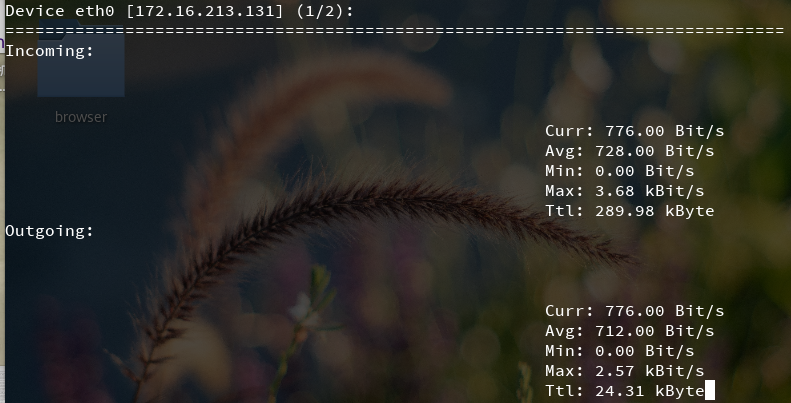
Iftop
Iftop measures the data flowing through individual socket connections, and it works in a manner that is different from Nload.
Iftop uses the pcap library to capture the packets moving in and out of the network adapter, and then sums up the size and count to find the total bandwidth under use.
Although iftop reports the bandwidth used by individual connections, it cannot report the process name/id involved in the particular socket connection.
But being based on the pcap library, iftop is able to filter the traffic and report bandwidth usage over selected host connections as specified by the filter.
Iftop测量通过单个套接字连接流动的数据,它的工作方式与Nload不同。Iftop使用pcap库来捕获进出网络适配器的数据包,然后总结大小和计数,以查找正在使用的总带宽。虽然iftop报告单个连接使用的带宽,但它不能报告特定套接字连接中涉及的进程名称/ID。但是,基于pcap库,iftop可以过滤流量并根据筛选器指定的所选主机连接报告带宽使用情况。
- 操作系统支持: Linux、Unix
- 官方网站: http://www.ex-parrot.com/pdw/iftop/
- 当前版本: 0.17
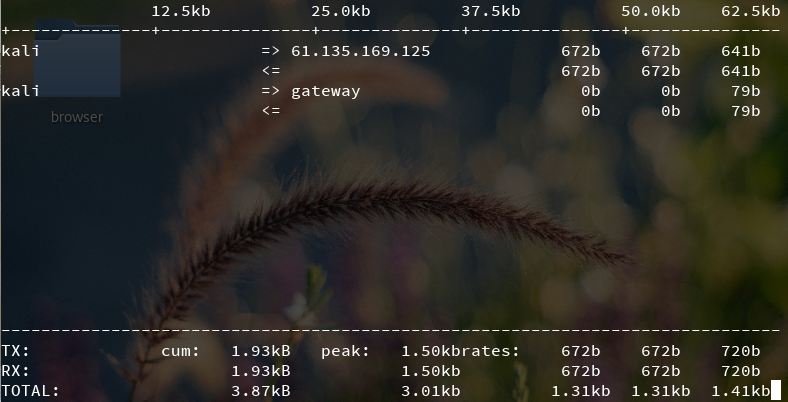
Iptraf
Iptraf is an interactive and colorful IP Lan monitor. It shows individual connections and the amount of data flowing between the hosts. Screenshot
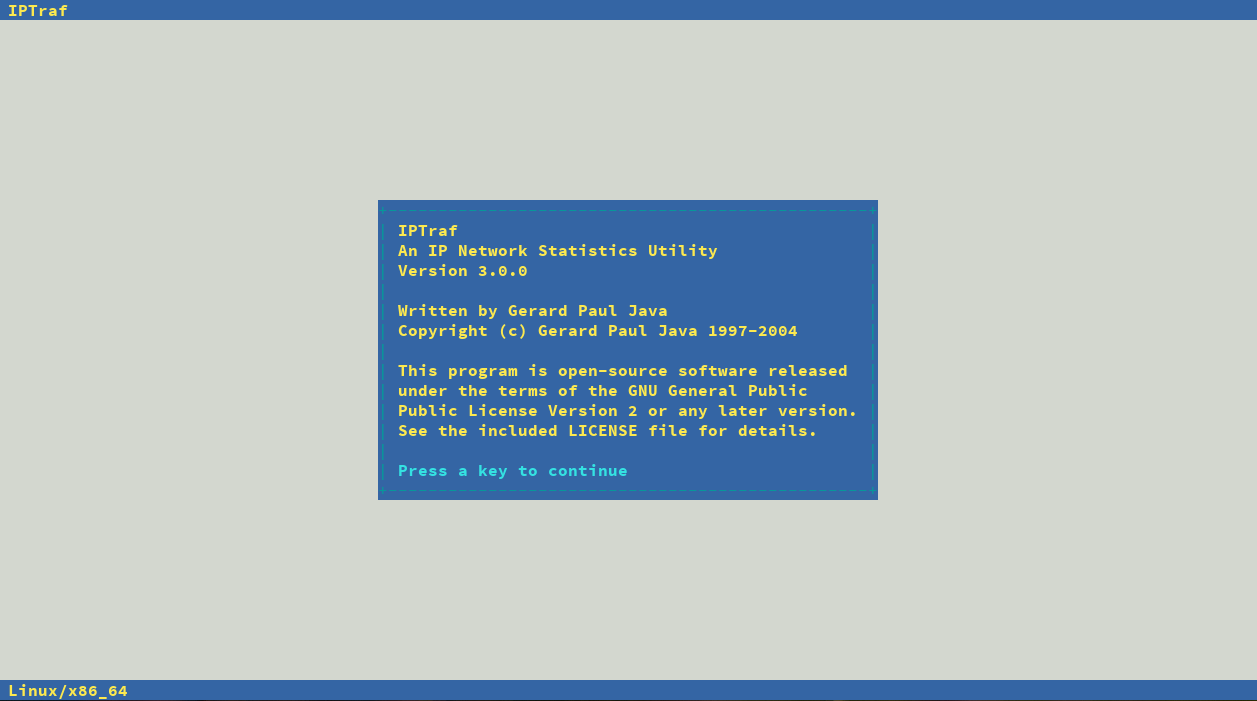
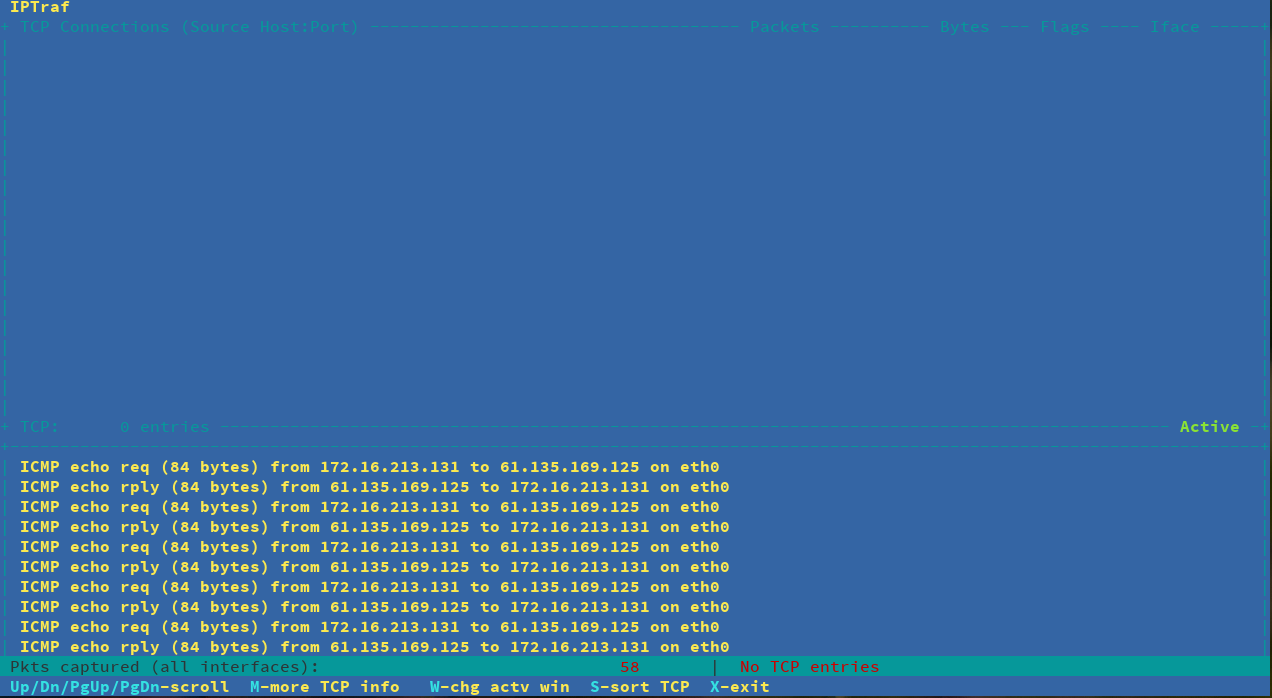
Nethogs
Nethogs is a small ‘net top’ tool that shows the bandwidth used by individual processes and sorts the list putting the most intensive processes on top. In the event of a sudden bandwidth spike, quickly open nethogs and find the process responsible. Nethogs reports the PID, user and the path of the program. Screenshot
Bmon
Bmon (Bandwidth Monitor) is a tool similar to nload that shows the traffic load over all the network interfaces on the system. The output also consists of a graph and a section with packet level details. Screenshot
Slurm
Slurm is ‘yet’ another network load monitor that shows device statistics along with an ascii graph. It supports 3 different styles of graphs each of which can be activated using the c, s and l keys. Simple in features, slurm does not display any further details about the network load. Screenshot
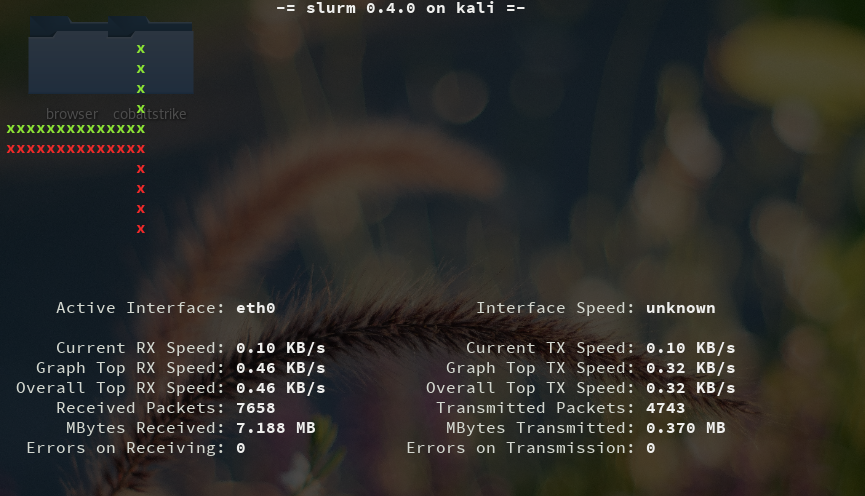
Tcptrack
Tcptrack is similar to iftop, and uses the pcap library to capture packets and calculate various statistics like the bandwidth used in each connection. It also supports the standard pcap filters that can be used to monitor specific connections. Screenshot
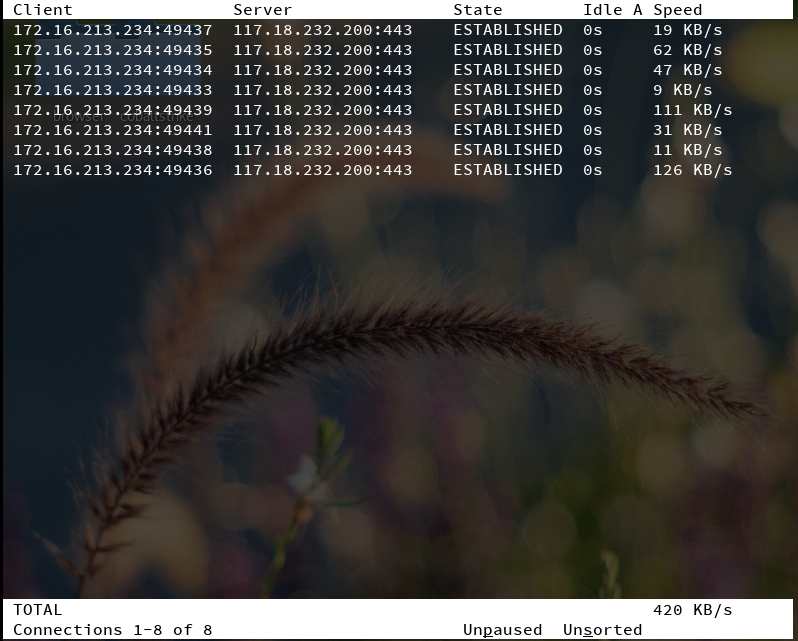
Vnstat
Vnstat is bit different from most of the other tools. It actually runs a background service/daemon and keeps recording the size of data transfer all the time. Next it can be used to generate a report of the history of network usage. Screenshot
Bwm-ng
Bwm-ng (Bandwidth Monitor Next Generation) is another very simple real time network load monitor that reports a summary of the speed at which data is being transferred in and out of all available network interfaces on the system. Screenshot

CBM (Color Bandwidth Meter)
A tiny little simple bandwidth monitor that displays the traffic volume through network interfaces. No further options, just the traffic stats are display and updated in realtime. Screenshot
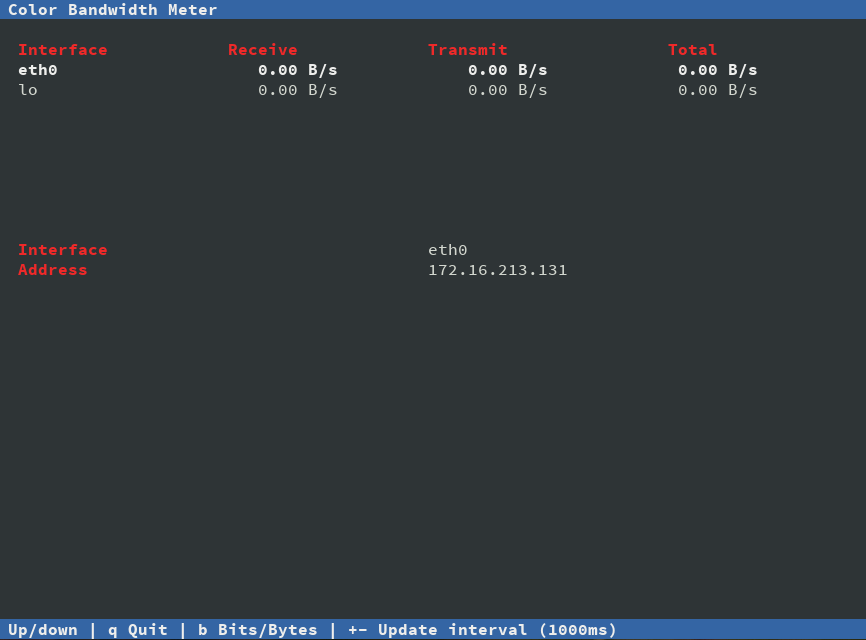
Speedometer
Another small and simple tool that just draws out good looking graphs of incoming and outgoing traffic through a given interface. Screenshot
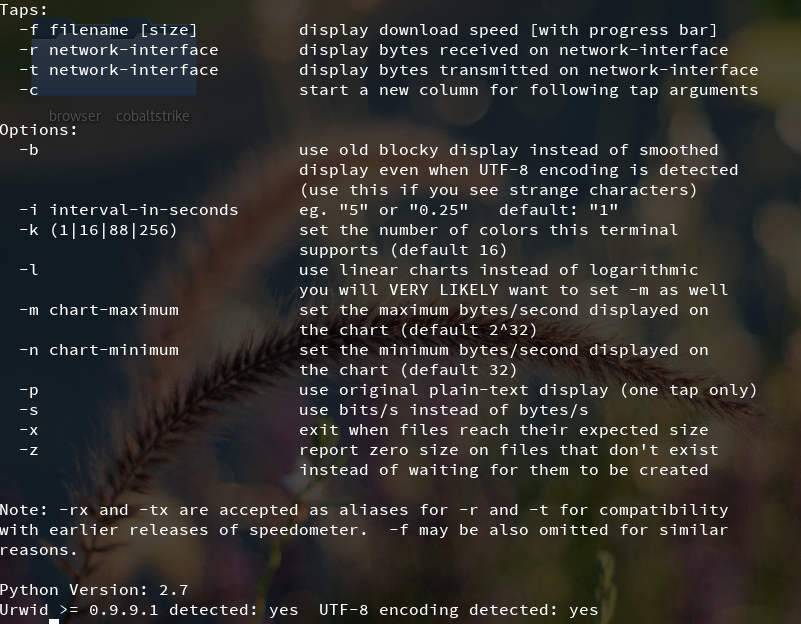
Pktstat
Pktstat displays all the active connections in real time, and the speed at which data is being transferred through them. It also displays the type of the connection, i.e. tcp or udp and also details about http requests if involved. Screenshot
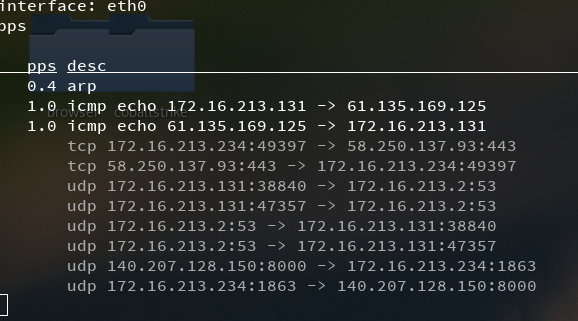
Netwatch
Netwatch is part of the netdiag collection of tools, and it too displays the connections between local host and other remote hosts, and the speed at which data is transferring on each connection. Screenshot
Trafshow
Like netwatch and pktstat, trafshow reports the current active connections, their protocol and the data transfer speed on each connection. It can filter out connections using pcap type filters. Screenshot
Netload
The netload command just displays a small report on the current traffic load, and the total number of bytes transferred since the program start. No more features are there. Its part of the netdiag. Screenshot
Ifstat
The ifstat reports the network bandwidth in a batch style mode. The output is in a format that is easy to log and parse using other programs or utilities. Screenshot
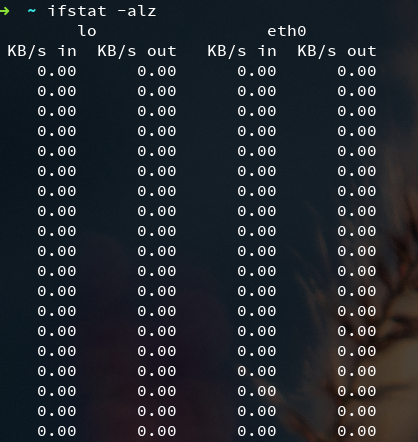
Dstat
Dstat is a versatile tool (written in python) that can monitor different system statistics and report them in a batch style mode or log the data to a csv or similar file. This example shows how to use dstat to report network bandwidth Screenshot

Collectl
Collectl reports system statistics in a style that is similar to dstat, and like dstat it is gathers statistics about various different system resources like cpu, memory, network etc. Over here is a simple example of how to use it to report network usage/bandwidth. Screenshot
流量捕获 (Traffic Capture)
Libpcap/Tcpdump (R)
The official site of tcpdump, a powerful command-line packet analyzer; and libpcap, a portable C/C++ library for network traffic capture. (http://www.tcpdump.org/)
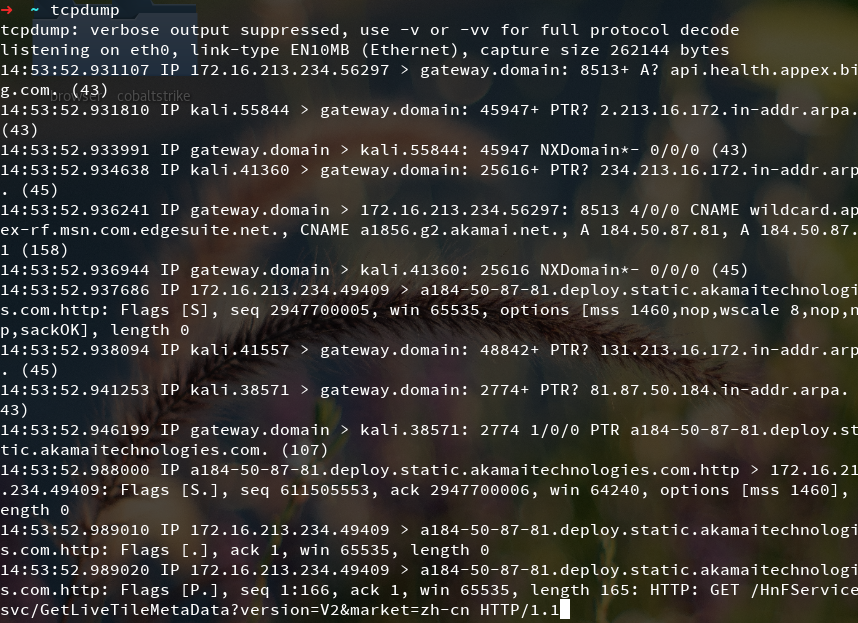
Ngrep
Ngrep strives to provide most of GNU grep’s common features, applying them to the network layer. ngrep is a pcap-aware tool that will allow you to specify extended regular or hexadecimal expressions to match against data payloads of packets. It currently recognizes TCP, UDP and ICMP across Ethernet, PPP, SLIP, FDDI, Token Ring and null interfaces, and understands bpf filter logic in the same fashion as more common packet sniffing tools, such as tcpdump and snoop. (http://www.packetfactory.net/Projects/ngrep)
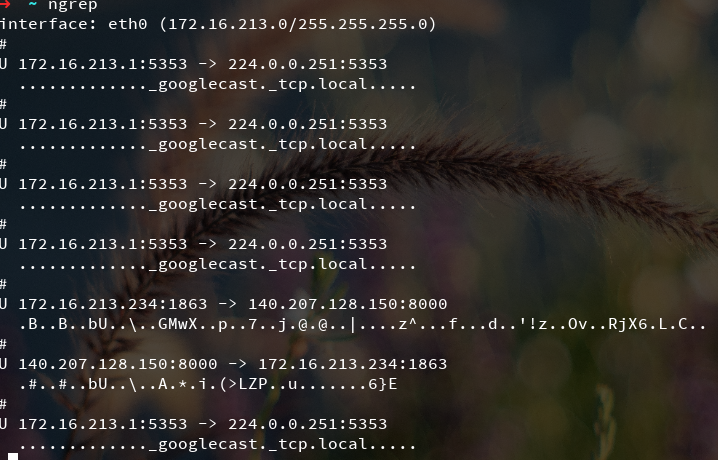
TTT: Tele Traffic Tapper
TTT is yet another descendant of tcpdump but it is capable of real-time, graphical, and remote traffic-monitoring. ttt won’t replace tcpdump, rather, it helps you find out what to look into with tcpdump. ttt monitors the network and automatically picks up the main contributors of the traffic within the time window. The graphs are updated every second by default. (http://www.csl.sony.co.jp/person/kjc/kjc/software.html#ttt)
n2disk (Commercial)
A multi-Gigabit network traffic recorder with indexing capabilities. n2disk is a network traffic recorder application. With n2disk you can capture full- sized network packets at multi-Gigabit rate (above 10 Gigabit/s on adequate hardware) from a live network interface, and write them into files without any packet loss. n2disk has been designed to write files into disks for very long periods, you have to specify a maximum number of distinct file that may be written during the execution, and if n2disk reaches the maximum number of files, it will start recycling the files from the oldest one. This way you can have a complete view of the traffic for a fixed temporal window … (http://www.ntop.org/products/n2disk/)
PF_RING
PF_RING is a new type of network socket that dramatically improves the packet capture speed, and that’s characterized by the following properties: Available for Linux kernels 2.6.32 and newer. No need to patch the kernel: just load the kernel module. PF_RING-aware drivers for increased packet capture acceleration. … (http://www.ntop.org/products/pf_ring/)
jNetPcap
jNetPcap is a packet capturing library for Java that is available for Linux and Windows. jNetPcap leverages libpcap respectively WinPcap and employs the Java Native Interface (JNI) for using the functionality provided by libpcap/WinPcap. (http://jnetpcap.com)
clj-net-pcap
clj-net-pcap is a packet capturing library for Clojure. clj-net-pcap uses jNetPcap and adds convenience functionality around jNetPcap for easing the usability. A paper about clj-net-pcap was published in scope of COMPSACW 2014: http://ieeexplore.ieee.org/xpl/articleDetails.jsp?tp=&arnumber=6903107 (https://github.com/ruedigergad/clj-net-pcap)
流量分析/检查 (Traffic Analysis/Inspection)
Wireshark suit (R)
The well-konwn tool suit to support packet analyzer and protocol decoder. (http://www.wireshark.org/) It also includes a few practical tools and scripts to support most of the common usage. Here is a brief list of these tools (http://wiki.wireshark.org/Tools)
WAND
A wonderful collection of tools built on libtrace to process network traffic, which is from The University of Waikato. I love this project! http://research.wand.net.nz/
Tcptrace (R)
A tool written by Shawn Ostermann at Ohio University, for analysis of TCP dump files. It can take as input the files produced by several popular packet- capture programs, including tcpdump, snoop, etherpeek, HP Net Metrix, and WinDump. tcptrace can produce several different types of output containing information on each connection seen, such as elapsed time, bytes and segments sent and recieved, retransmissions, round trip times, window advertisements, throughput, and more. It can also produce a number of graphs for further analysis. http://tcptrace.org/index.html
Tstat (R)
A passive sniffer able to provide several insight on the traffic patterns at both the network and transport levels with a tremendous set of flow features. http://tstat.tlc.polito.it/
Tcpsplit (R)
A tool to break a single libpcap packet trace into some number of sub- traces, breaking the trace along TCP connection boundaries so that a TCP connection doesn’t end up split across two sub-traces. This is useful for making large trace files tractable for in- depth analysis and for subsetting a trace for developing analysis on only part of a trace. http://www.icir.org/mallman/software/tcpsplit/
Tcpflow (R)
A program that captures data transmitted as part of TCP connections (flows), and stores the data in a way that is convenient for protocol analysis or debugging. A program like ‘tcpdump’ shows a summary of packets seen on the wire, but usually doesn’t store the data that’s actually being transmitted. In contrast, tcpflow reconstructs the actual data streams and stores each flow in a separate file for later analysis. (Original) http://www.circlemud.org/jelson/software/tcpflow/ or (Newest) https://github.com/simsong/tcpflow
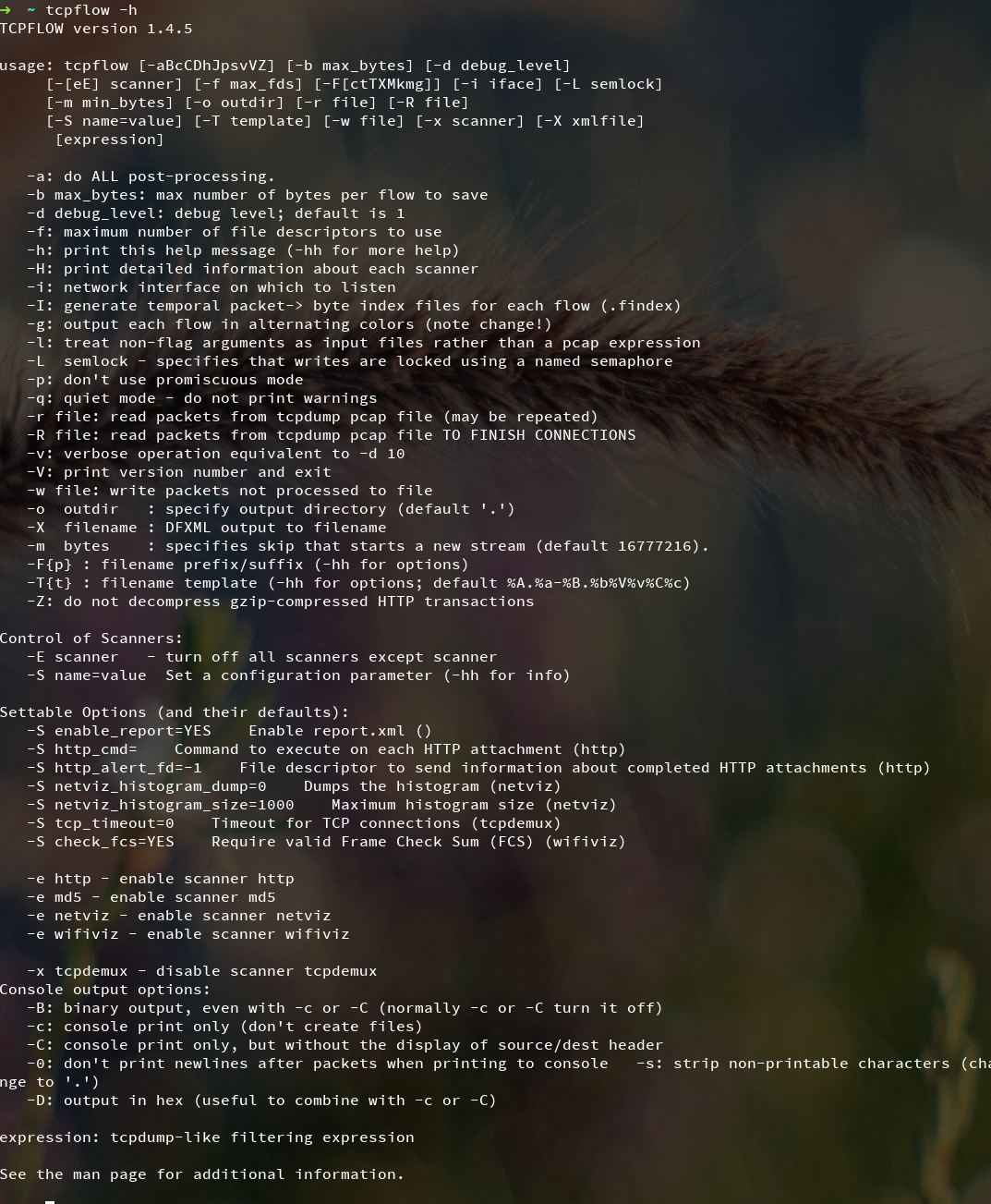
Tcpreplay
Replays a pcap file on an interface using libnet. http://tcpreplay.synfin.net/
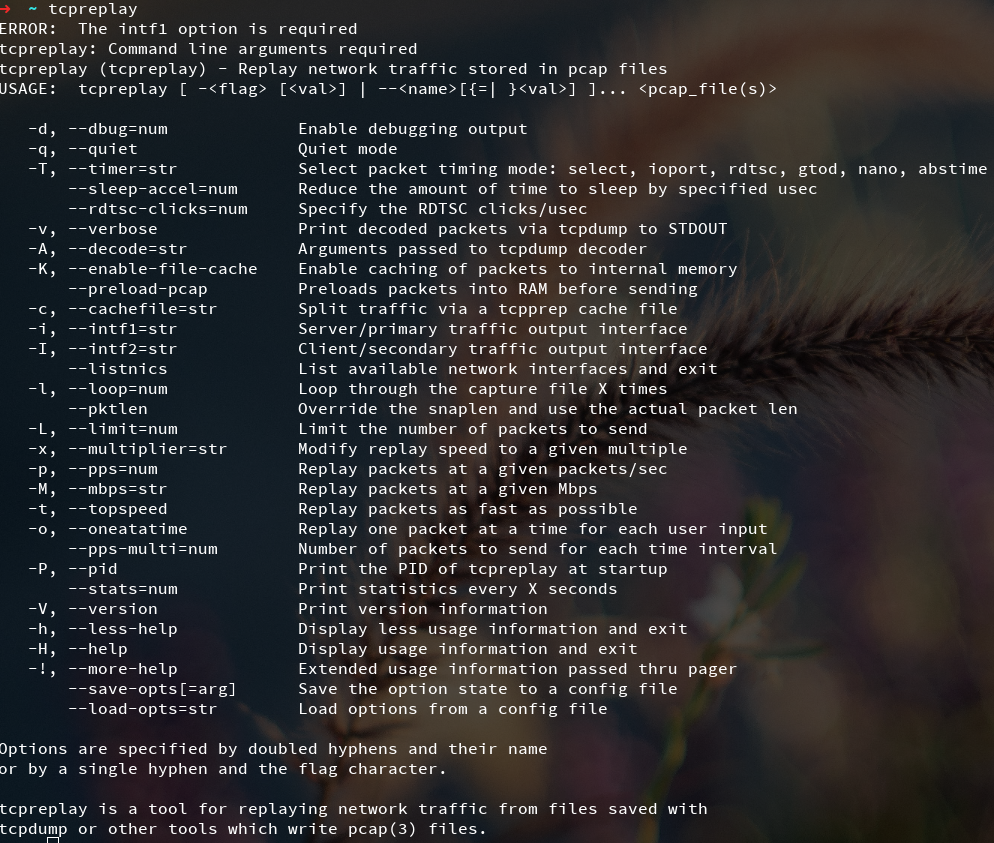
Tcpstat
Tcpstat reports certain network interface statistics much like vmstat does for system statistics. tcpstat gets its information by either monitoring a specific interface, or by reading previously saved tcpdump data from a file. http://www.frenchfries.net/paul/tcpstat/
Tcplook
Tracelook is an Tcl/TK program for graphically viewing the contents of trace files created using the -w argument to tcpdump. Tracelook should look at all protocols, but presently only looks at TCP connections. The program is slow and uses system resources prodigiously. http://ita.ee.lbl.gov/html/contrib/tracelook.html
Tcpdpriv
Tcpdpriv is program for eliminating confidential information (user data and addresses) from packets collected on a network interface (or, from trace files created using the -w argument to tcpdump). Tcpdpriv removes the payload of TCP and UDP, and the entire IP payload for other protocols. It implements several address scrambling methods; the sequential numbering method and its variants, and a hash method with preserving address prefix. http://ita.ee.lbl.gov/html/contrib/tcpdpriv.html
Tcpslice
Tcpslice is a tool for extracting portions of packet trace files generated using tcpdump’s -w flag. It can combine multiple trace files, and/or extract portions of one or more traces based on time. TCPslice originally comes from: ftp://ftp.ee.lbl.gov/tcpslice.tar.gz also mirrored here. tcpslice can also be found in the tcpdump CVS server, as the project tcpslice. ftp://ftp.ee.lbl.gov/tcpslice.tar.gz

TCP-Reduce
TCP-Reduce is a collection of Bourne shell scripts for reducing tcpdump traces to one-line summaries of each TCP connection present in the trace. The scripts look only at TCP SYN/FIN/RST packets. Connections without SYN packets in the trace (such as those on-going at the beginning of the trace) will not appear in the summary. Garbaged packets (those missing some of their contents) are reported to stderr as bogon’s and are discarded. Occasionally the script gets fooled by retransmissions with altered sequence numbers, and reports erroneous huge connection sizes - always check large connections (say 100 MB or more) for plausibility. http://ita.ee.lbl.gov/html/contrib/tcp-reduce.html
dpkt
Python packet creation/parsing library. http://code.google.com/p/dpkt/
Pcap2har
A program to convert .pcap network capture files to HTTP Archive files using library dpkt. https://github.com/andrewf/pcap2har
Libnet
Libnet is a collection of routines to help with the construction and handling of network packets. It provides a portable framework for low-level network packet shaping, handling and injection. Libnet features portable packet creation interfaces at the IP layer and link layer, as well as a host of supplementary and complementary functionality. Using libnet, quick and simple packet assembly applications can be whipped up with little effort. http://www.packetfactory.net/Projects/Libnet/
Libnids
Libnids, designed by Rafal Wojtczuk, is an implementation of an E-component of Network Intrusion Detection System. It emulates the IP stack of Linux 2.0.x. Libnids offers IP defragmentation, TCP stream assembly and TCP port scan detection. The most valuable feature of libnids is reliability. A number of tests were conducted, which proved that libnids predicts behaviour of protected Linux hosts as closely as possible. http://libnids.sourceforge.net/
ECap
Ecap (external capture) is a distributed network sniffer with a web front- end. Ecap was written many years ago in 2005, but a post on the tcpdump-workers mailing list requested a similar application… so here it is. It would be fun to update it and work on it again if there’s any interest. https://bitbucket.org/nathanj/ecap/wiki
appspider.postman_collection.json
HttpSniffer
A multi-threading tool to sniff TCP flow statistics and embedded HTTP headers from PCAP file. Each TCP flow carrying HTTP is exported to text file in JSON format. https://github.com/caesar0301/http-sniffer
AIEngine
AIEngine is a next generation interactive/programmable packet inspection engine with capabilities of learning without any human intervention, NIDS functionality, DNS domain classification, network collector and many others. AIEngine also helps network/security professionals to identify traffic and develop signatures for use them on NIDS, Firewalls, Traffic classifiers and so on. Available on https://bitbucket.org/camp0/aiengine
Network Expect
Network Expect is a framework that allows to easily build tools that can interact with network traffic. Following a script, traffic can be injected into the network, and decisions can be taken, and acted upon, based on received network traffic. An interpreted language provides branching and high-level control structures to direct the interaction with the network. Network Expect uses libpcap for packet capture and libwireshark (from the Wireshark project) for packet dissection tasks. (GPL, BSD/Linux/OSX) Submitted by: Eloy Paris {peloy at chapus.net} http://www.netexpect.org/
Socket Sentry
Socket Sentry is a real-time network traffic monitor for KDE Plasma in the same spirit as tools like iftop and netstat. Submitted by: Rob Hasselbaum {rob at hasselbaum.net} http://code.google.com/p/socket-sentry
Sniff
Makes output from the tcpdump program easier to read and parse. http://www.thedumbterminal.co.uk/software/sniff.html
EtherApe
EtherApe is a graphical network monitor for Unix modeled after etherman. Featuring link layer, ip and TCP modes, it displays network activity graphically. Hosts and links change in size with traffic. Color coded protocols display. It supports Ethernet, FDDI, Token Ring, ISDN, PPP and SLIP devices. It can filter traffic to be shown, and can read traffic from a file as well as live from the network. http://etherape.sourceforge.net/
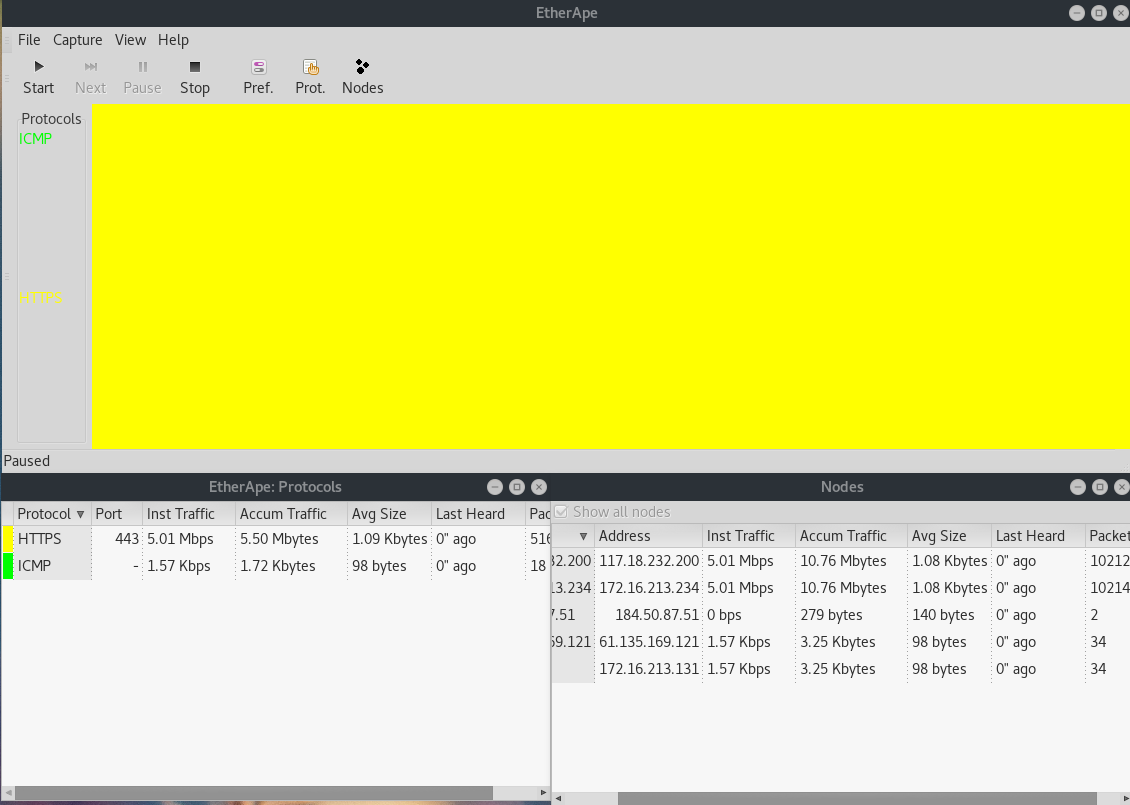
Snort
Snort is an open source network intrusion prevention and detection system (IDS/IPS) developed by Sourcefire. Combining the benefits of signature, protocol and anomaly- based inspection, Snort is the most widely deployed IDS/IPS technology worldwide. With millions of downloads and approximately 300,000 registered users, Snort has become the de facto standard for IPS. http://www.snort.org/
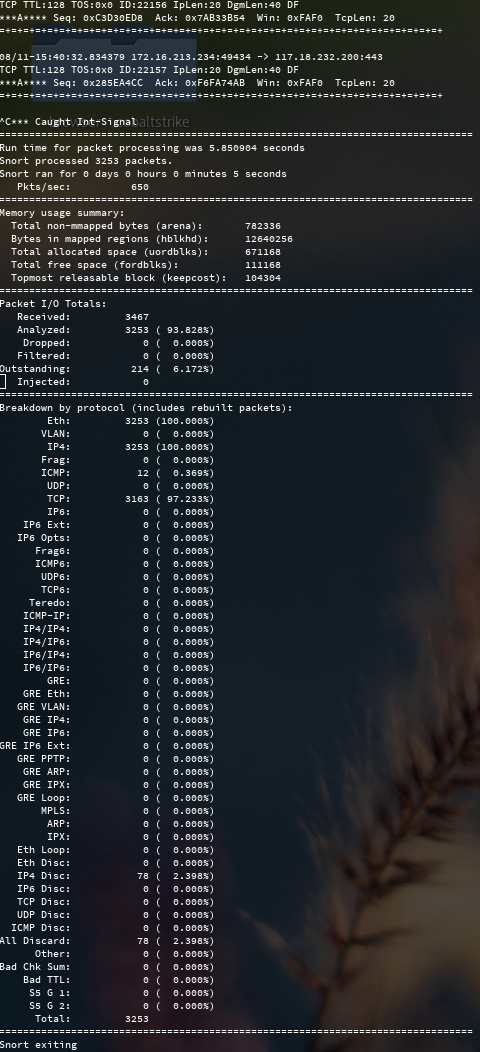
Scapy
Scapy is a powerful interactive packet manipulation program. It is able to forge or decode packets of a wide number of protocols, send them on the wire, capture them, match requests and replies, and much more. It can easily handle most classical tasks like scanning, tracerouting, probing, unit tests, attacks or network discovery (it can replace hping, 85% of nmap, arpspoof, arp-sk, arping, tcpdump, tethereal, p0f, etc.). It also performs very well at a lot of other specific tasks that most other tools can’t handle, like sending invalid frames, injecting your own 802.11 frames, combining technics (VLAN hopping+ARP cache poisoning, VOIP decoding on WEP encrypted channel, …), etc. http://www.secdev.org/projects/scapy/
Bro
Bro is an open-source, Unix-based Network Intrusion Detection System (NIDS) that passively monitors network traffic and looks for suspicious activity. Bro detects intrusions by first parsing network traffic to extract its application- level semantics and then executing event-oriented analyzers that compare the activity with patterns deemed troublesome. Its analysis includes detection of specific attacks (including those defined by signatures, but also those defined in terms of events) and unusual activities (e.g., certain hosts connecting to certain services, or patterns of failed connection attempts). http://bro- ids.org/
Ntop
Ntop is a network traffic probe that shows the network usage, similar to what the popular top Unix command does. ntop is based on libpcap and it has been written in a portable way in order to virtually run on every Unix platform and on Win32 as well. http://www.ntop.org/

CoralReef
CoralReef is a software suite developed by CAIDA to analyze data collected by passive Internet traffic monitors. It provides a programming library libcoral, similar to libpcap with extensions for ATM and other network types, which is available from both C and Perl. The software presently supports dedicated PC boxes using OC3mon and OC12mon cards that collect traffic data in real time, as well as reading from pcap tracefiles. Version 3.4 to be released soon supports listening via bpf enabled devices. CoralReef includes drivers, analysis, web report generation, examples, and capture software. This package is maintained by CAIDA developers with the support and collaboration of the Internet measurement community. http://www.caida.org/tools/measurement/coralreef/
Xplot
The program xplot was written in the late 1980s to support the analysis of TCP packet traces. http://www.xplot.org/
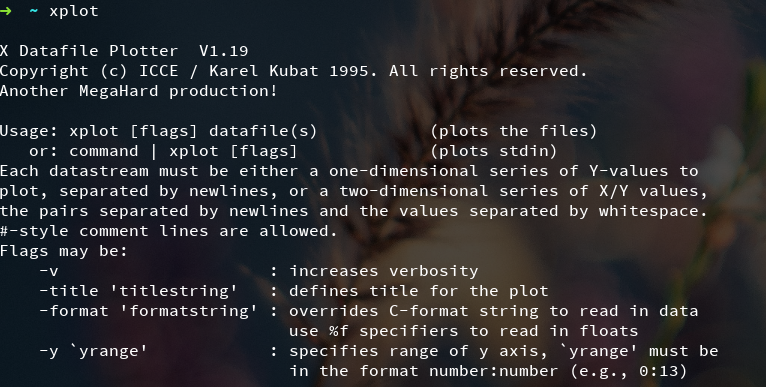
Multitail
MultiTail now has a colorscheme included for monitoring the tcpdump output. It can also filter, convert timestamps to timestrings and much more. http://www.vanheusden.com/multitail
Netsniff-ng
Netsniff-ng is a toolkit of free Linux networking utilities, a Swiss army knife for your daily Linux network plumbing if you will. http://netsniff- ng.org/ or on GitHub.
NetDude
Netdude (NETwork DUmp data Displayer and Editor). From their webpage, “it is a GUI-based tool that allows you to make detailed changes to packets in tcpdump tracefiles.” http://netdude.sourceforge.net/
Libcrafter
Libcrafter is a high level library for C++ designed to make easier the creation and decoding of network packets. It is able to craft or decode packets of most common network protocols, send them on the wire, capture them and match requests and replies. Submitted by: Esteban Pellegrino http://code.google.com/p/libcrafter/
WinPcap info
An extract of a message from Guy Harris on state of WinPcap and WinDump. http://www.tcpdump.org/wpcap.html
Sniffer
The Sniffer product family covers different fields of application (Distributed, Portable and Wireless Environment). Sniffer solutions monitor, troubleshoot, analyze, report on, and proactively manage network performance. They ensure peak performance throughout the enterprise infrastructure, across all LAN, WAN and high-speed topologies, from 10/100 Ethernet to the latest high-speed Asynchronous ATM, Gigabit, and Packet-over-SONET (PoS) backbones. http://www.sniffer.com/products/sniffer-basic/default.asp?A=2
Traffic Data Repository at the WIDE Project
It becomes increasingly important for both network researchers and operators to know the trend of network traffic and to find anomaly in their network traffic. This paper describes an on-going effort within the WIDE project to collect a set of free tools to build a traffic data repository containing detailed information of our backbone traffic. Traffic traces are collected by tcpdump and, after removing privacy information, the traces are made open to the public. We review the issues on user privacy, and then, the tools used to build the WIDE traffic repository. We will report the current status and findings in the early stage of our IPv6 deployment. http://www.sonycsl.co.jp/person/kjc/papers/freenix2000/
ITA: Internet Traffic Archive
The Internet Traffic Archive is a moderated repository to support widespread access to traces of Internet network traffic, sponsored by ACM SIGCOMM. The traces can be used to study network dynamics, usage characteristics, and growth patterns, as well as providing the grist for trace- driven simulations. The archive is also open to programs for reducing raw trace data to more manageable forms, for generating synthetic traces, and for analyzing traces. http://www.sigcomm.org/ITA/
Sanitize
Sanitize is a collection of five Bourne shell scripts for reducing tcpdump traces in order to address security and privacy concerns, by renumbering hosts and stripping out packet contents. Each script takes as input a tcpdump trace file and generates to stdout a reduced, ASCII file in fixed-column format. http://ita.ee.lbl.gov/html/contrib/sanitize.html
Ipsumdump (posted by adulau 2012-12-25)
The ipsumdump program summarizes TCP/IP dump files into a self-describing ASCII format easily readable by humans and programs. Ipsumdump can read packets from network interfaces, from tcpdump files, and from existing ipsumdump files. It will transparently uncompress tcpdump or ipsumdump files when necessary. It can randomly sample traffic, filter traffic based on its contents, anonymize IP addresses, and sort packets from multiple dumps by timestamp. Also, it can optionally create a tcpdump file containing actual packet data. It’s also convinient to work with CLICK as a inserted module. For more info, please read: http://www.read.seas.harvard.edu/~kohler/ipsumdump/
Ntopng
Ntopng is the next generation version of the original ntop, a network traffic probe that shows the network usage, similar to what the popular top Unix command does. ntop is based on libpcap and it has been written in a portable way in order to virtually run on every Unix platform, MacOSX and on Win32 as well. (http://www.ntop.org/products/ntop/)
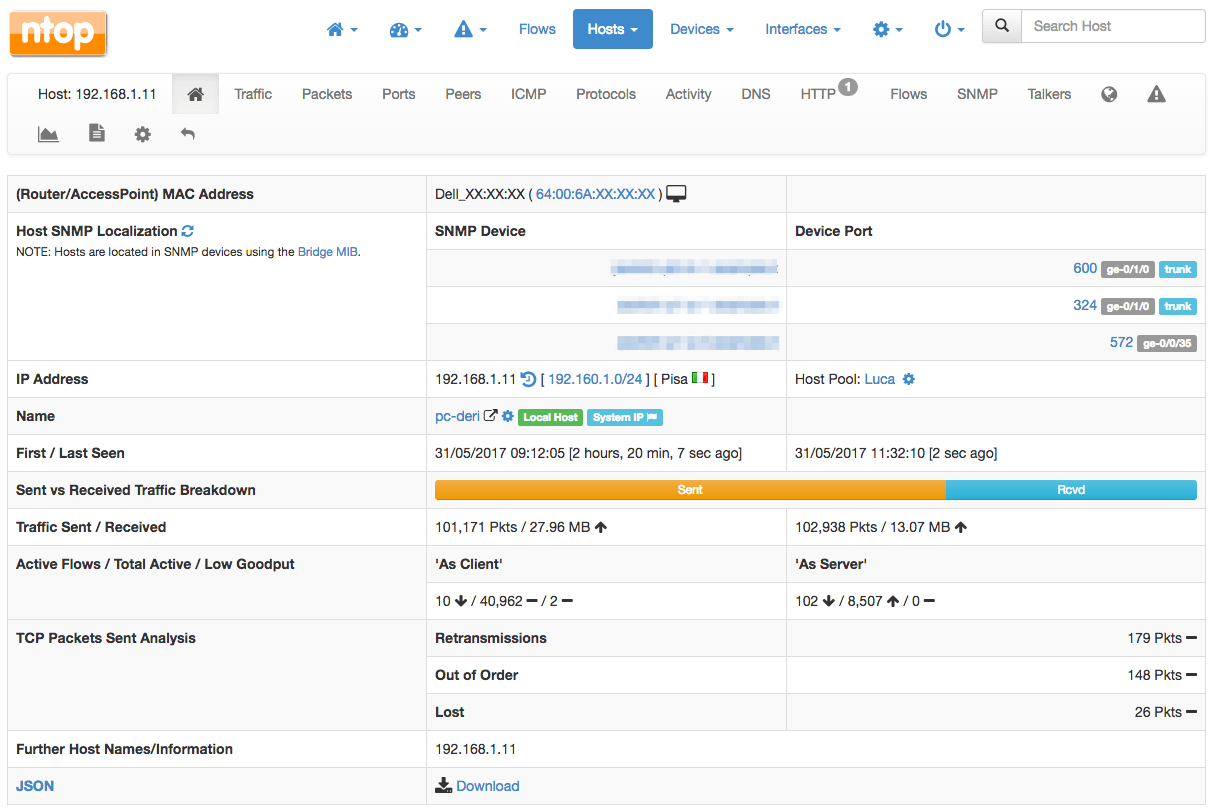
文件提取 (File Extraction)
Xplico
The goal of Xplico is extract from an internet traffic capture the applications data contained. For example, from a pcap file Xplico extracts each email (POP, IMAP, and SMTP protocols), all HTTP contents, each VoIP call (SIP), FTP, TFTP, and so on. Xplico isn’t a network protocol analyzer. Xplico is an open source Network Forensic An alysis Tool (NFAT). Xplico is released under the GNU General Public License and with some scripts under Creative Commons Attribution-NonCommercial-ShareAlike 3.0 Unported (CC BY-NC-SA 3.0) License. http://www.xplico.org/about
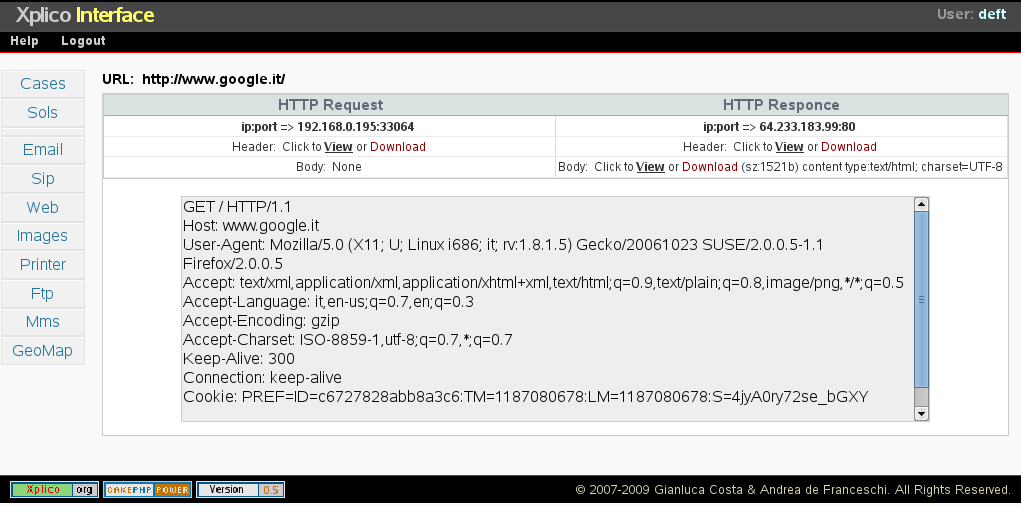
Justniffer
Justniffer is a network protocol analyzer that captures network traffic and produces logs in a customized way, can emulate Apache web server log files, track response times and extract all “intercepted” files from the HTTP traffic. http://justniffer.sourceforge.net/

NetworkMiner
NetworkMiner is a Network Forensic Analysis Tool (NFAT) for Windows (but also works in Linux / Mac OS X / FreeBSD). NetworkMiner can be used as a passive network sniffer/packet capturing tool in order to detect operating systems, sessions, hostnames, open ports etc. without putting any traffic on the network. NetworkMiner can also parse PCAP files for off-line analysis and to regenerate/ reassemble transmitted files and certificates from PCAP files. http://www.netresec.com/?page=NetworkMiner
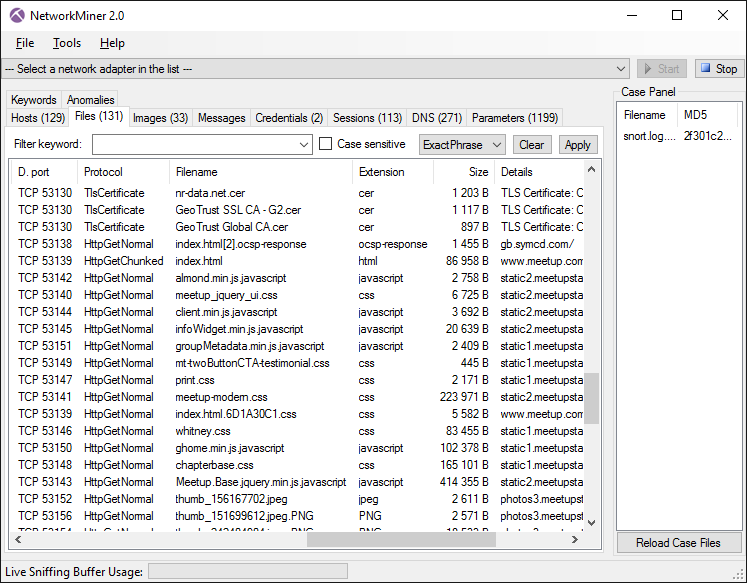
Tcpxtract
Tcpxtract is a tool for extracting files from network traffic based on file signatures. Extracting files based on file type headers and footers (sometimes called “carving”) is an age old data recovery technique. Tools like Foremost employ this technique to recover files from arbitrary data streams. Tcpxtract uses this technique specifically for the application of intercepting files transmitted across a network. Other tools that fill a similar need are driftnet and EtherPEG. driftnet and EtherPEG are tools for monitoring and extracting graphic files on a network and is commonly used by network administrators to police the internet activity of their users. The major limitations of driftnet and EtherPEG is that they only support three filetypes with no easy way of adding more. The search technique they use is also not scalable and does not search across packet boundries. tcpxtract features the following: http://tcpxtract.sourceforge.net/

Foremost
Foremost is a console program to recover files based on their headers, footers, and internal data structures. This process is commonly referred to as data carving. Foremost can work on image files, such as those generated by dd, Safeback, Encase, etc, or directly on a drive. The headers and footers can be specified by a configuration file or you can use command line switches to specify built-in file types. These built-in types look at the data structures of a given file format allowing for a more reliable and faster recovery. http://foremost.sourceforge.net/

Dsniff
Dsniff is a collection of tools for network auditing and penetration testing. dsniff, filesnarf, mailsnarf, msgsnarf, urlsnarf, and webspy passively monitor a network for interesting data (passwords, e-mail, files, etc.). arpspoof, dnsspoof, and macof facilitate the interception of network traffic normally unavailable to an attacker (e.g, due to layer-2 switching). sshmitm and webmitm implement active monkey-in-the-middle attacks against redirected SSH and HTTPS sessions by exploiting weak bindings in ad-hoc PKI. http://www.monkey.org/~dugsong/dsniff/
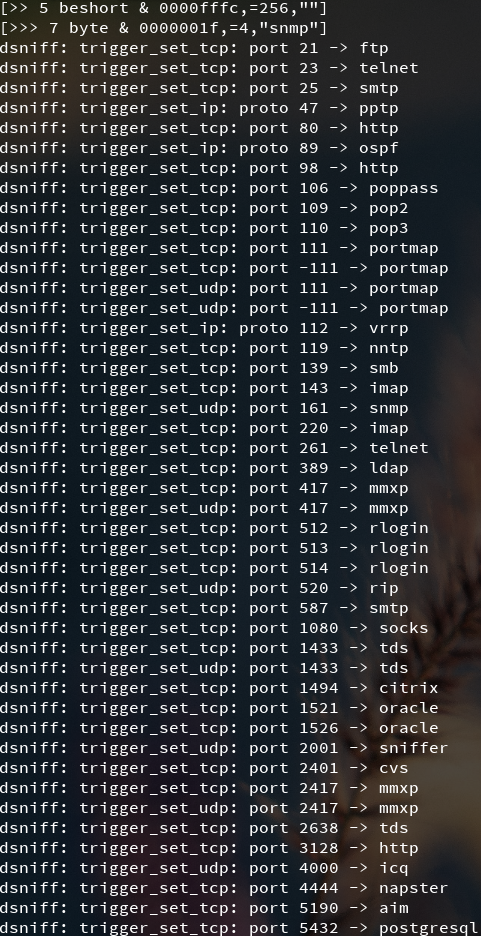
Chaosreader
A freeware tool to trace TCP/UDP/… sessions and fetch application data from snoop or tcpdump logs. This is a type of “any-snarf” program, as it will fetch telnet sessions, FTP files, HTTP transfers (HTML, GIF, JPEG, …), SMTP emails, … from the captured data inside network traffic logs. A html index file is created that links to all the session details, including realtime replay programs for telnet, rlogin, IRC, X11 and VNC sessions; and reports such as image reports and HTTP GET/POST content reports. Chaosreader can also run in standalone mode - where it invokes tcpdump or snoop (if they are available) to create the log files and then processes them. http://chaosreader.sourceforge.net/
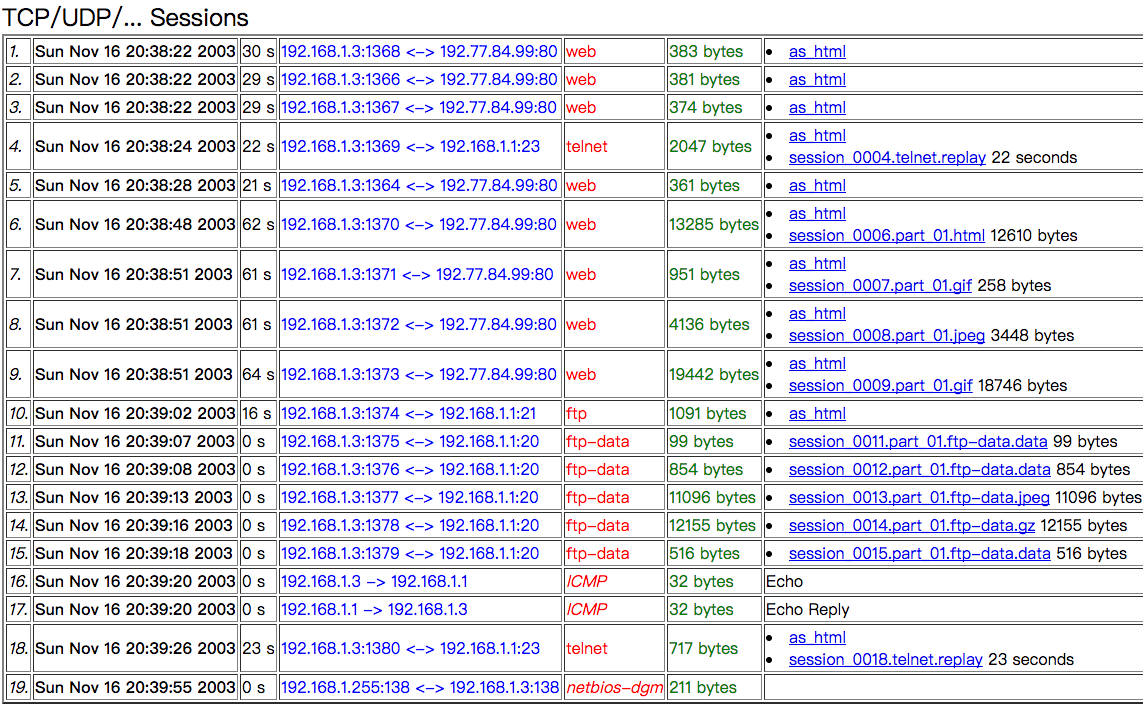
Tcpick
Tcpick is a textmode sniffer libpcap-based that can track, reassemble and reorder tcp streams. Tcpick is able to save the captured flows in different files or displays them in the terminal, and so it is useful to sniff files that are transmitted via ftp or http. It can display all the stream on the terminal, when the connection is closed in different display modes like hexdump, hexdump
ascii, only printable charachters, raw mode and so on. Available a color mode too, helpful to read and understand better the output of the program. Actually it can handle several interfaces, including ethernet cards and ppp. It is useful to keep track of what users of a network are doing, and is usable with textmode tools like grep, sed, awk. http://tcpick.sourceforge.net/
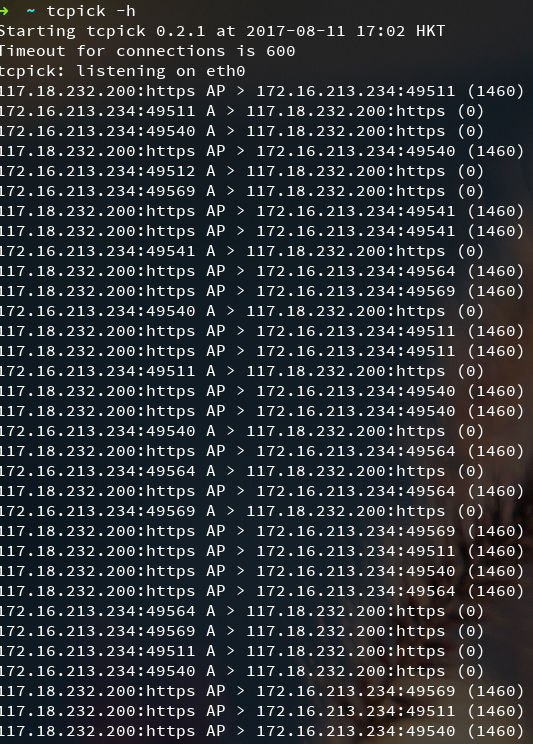
其他项目 (Other Projects)
FFT-FGN-C
FFT-FGN-C is a program for synthesizing a type of self-similar process known as fractional Gaussian noise. The program is fast but approximate. Fractional Gaussian noise is only one type of self-similar process. When using this program for synthesizing network traffic, you must keep in mind that it may be that the traffic you seek is better modeled using one of the other processes. The output of the program (perhaps transformed - see the documentation) describes an arrival process, not an interarrival process. That is, the output can be interpreted as a count of network arrivals during a particular time interval; but if your application requires exact arrival times, a separate mechanism is needed to transform the count into individual arrivals (doing this is a research area). http://ita.ee.lbl.gov/html/contrib/fft_fgn_c.html
Usenix 93 paper on BPF
The libpcap interface supports a filtering mechanism based on the architecture in the BSD packet filter. BPF is described in the 1993 Winter Usenix paper “The BSD Packet Filter: A New Architecture for User-level Packet Capture”.
- The original is at: ftp://ftp.ee.lbl.gov/papers/bpf-usenix93.ps.Z
- A copy (compressed postscript 144K): http://www.tcpdump.org/papers /bpf-usenix93.ps.Z
- Gzip’ed postscript: http://www.tcpdump.org/papers/bpf-usenix93.ps.gz (100K)
- For the Post-script impaired, here is some PDF:bpf-usenix93.pdf (135K)
BPF for Ultrix
A distribution of BPF for Ultrix 4.2, with both source code and binary modules. http://www.tcpdump.org/other/bpfext42.tar.Z
BPF+
Exploiting Global Data-flow Optimization in a Generalized Packet Filter Architecture By Andrew Begel, Steven McCanne, and Susan Graham, originally at: http://www.cs.berkeley.edu/~abegel/sigcomm99/bpf+.ps
DPF
A paper presented at SIGCOMM ‘96 on an enhanced version of BPF. http://www.pdos.lcs.mit.edu/~engler/dpf.html
原文地址: http://xiaming.me/awesome-pcaptools/
History
- Update 2014-07-24: Traffic moniter tools under *nix (http://bit.do/J8qM)
- Update 2013-01-01: Another similar list from Wireshark (http://wiki.wireshark.org/Tools)
- Update 2012-12-26: A similar collection of web version: (http://bit.do/J8q4)